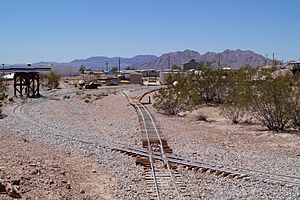Nevada State Railroad Museum Boulder City facts for kids
The Nevada State Railroad Museum Boulder City is a fun place in Boulder City, Nevada, where you can learn all about trains! It's part of the Nevada Department of Tourism and Cultural Affairs. This museum is built on the old Boulder City Branch Line, which was a historic railroad track used to help build the famous Hoover Dam. The state got these tracks from the Union Pacific Railroad in 1985.
Ride a Historic Train!
The museum has a special heritage railroad where you can ride on old trains! These passenger trains take you on a 7-mile trip that lasts about 45 minutes. Train rides started in 2002. You can even arrange to ride in the front of the train with the driver (the locomotive cab), in the back (the caboose), or even learn to operate a train yourself! Just make sure to book ahead.
One of the most famous trains you can ride is a former Union Pacific EMD GP30 locomotive, named No. 844. This train is super strong, weighing about 125 tons! It has a powerful V16 engine that makes 2250 horsepower. It was given to the museum and painted in its original Union Pacific colors. This specific No. 844 was so well-known that another famous steam locomotive, also named 844, had to change its number to 8444 for many years so people wouldn't get them mixed up!
A big project called Interstate 11 helped the railroad. The NDOT replaced a bridge over US Route 93 that had been closed since 1998. In April 2018, a new way for the road and tracks to cross was built near Railroad Pass Casino. This reconnected Boulder City and Henderson by rail.
Cool Trains and Exhibits
The museum has many different types of trains and railroad equipment. You can see old steam locomotives, powerful diesel engines, and special cars. Some trains are on display for you to look at, while others are still working and sometimes used for special events.
For example, they have a Baldwin-built steam engine from 1907 that was once used by the UPRR. There's also a Fairbanks-Morse diesel locomotive from 1953 that used to belong to the U.S. Army. You can also see different types of cabooses and even a private business car from 1899!
Tiny Trains!
The museum also has a really cool miniature railway! These tiny trains are 1/8th the size of real trains. They run on a 7.5-inch wide track. Both kids and adults can easily ride on these fun, small trains.
See also
- Nevada State Railroad Museum – another railroad museum in Carson City, Nevada
Images for kids























